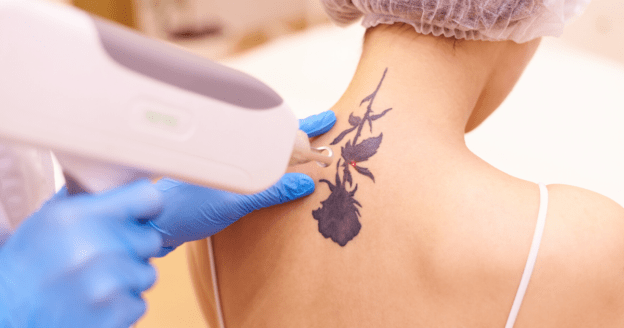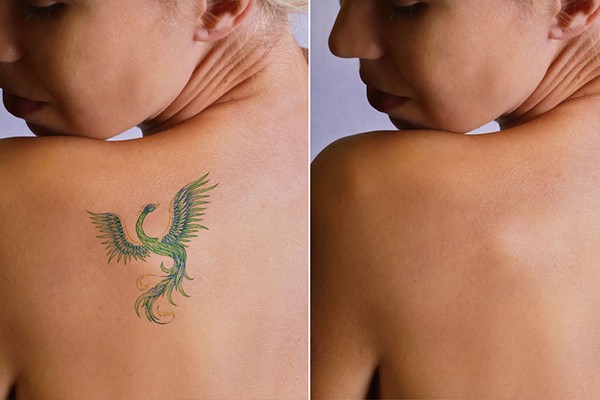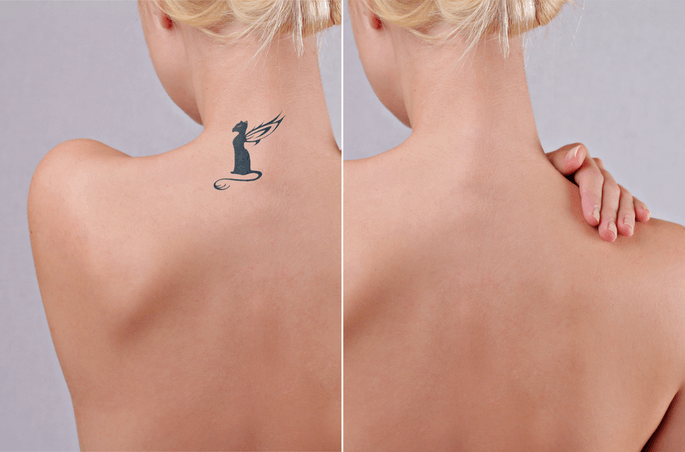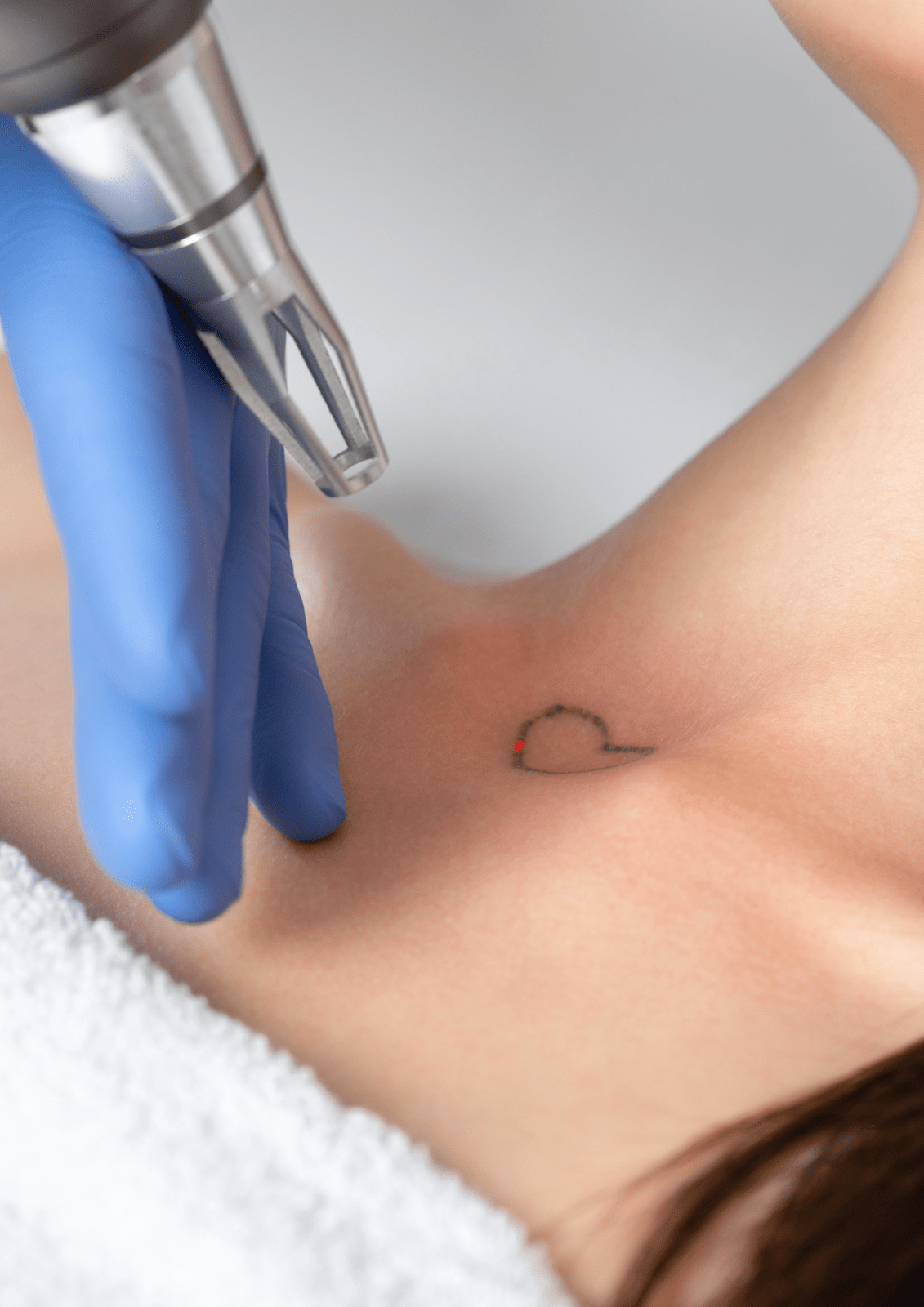Laser Tattoo Removal
What to know about
Laser Tattoo Removal
Nearly 30% of people all over the world. have at least one tattoo. Almost half of all new generation and millennials have one. Unfortunately, not all of the people are happy about their tattoo decision. As many as 25% of people with a tattoo marking say they regret getting it. If you’re in that 25%, there is good news. Laser tattoo removal techniques can get rid of your unwanted tattoo with the minimal amount of possible side effects.


Learn about
How laser tattoo removal works:
Lasers (Picosecond and q-switch) remove tattoos by fracturing the pigment particles with a high-intensity light beam. Black tattoo pigment absorbs all wavelengths beamed from the laser crystal, making it the least complex colour to remove from the skin. Other colours (Like green, red and white) can only be treated by selected laser wavelength (532nm, 755nm) based upon the pigment colour. The Client should first schedule a consultation with a professional removal therapist who can pre-evaluate the tattoo marking and make a few suggestions on the process or a treatment plan accordingly. The number of treatments one will need will depend on the tattoo ink quality, the age of the tattoo, the size, the type of tattoo (line-work or shading) and colours of the unwanted tattoo. The colour of the client skin, as well as how deep the tattoo ink goes, will also be a contributing factor that can affect the removal process.

What to expect
During the Laser tattoo removal procedure
During your appointment the client will be supplied with a pair of protective eye shields. The tattoo removal therapist will do a test patch on the client’s skin, to test the reaction to the laser to establish the most efficient energy for treatment without damaging the skin. The technician uses the laser to pass pulses of high intensity light through the superficial layers of the skin that will be consumed by the tattoo pigment only.
Smaller and more line-work type of tattoos will require less pulses while larger bigger and shaded ones will need more pulses to remove the tattoos. In either case, to completely remove a tattoo, it will require a few (6-8) treatments. After each visit, your tattoo should become gradually lighter.
Unfortunately, laser tattoo removal is not one of the most comfortable treatments, but most clients don’t need some form of numbing agent. Pain experienced purely depends on the location of the tattoo, Trivine only applies local anaesthetic to the face in cases of permanent makeup removal.
Directly after the treatment, it can be quite useful to apply an ice pack to soothe the treated area and apply an antibacterial, antibiotic cream or a vitamin ointment and bandage to protect it (which is not compulsory). Ensure that the treated area should also be protected with sunblock everyday.


What are the
Possible side Effects
Laser tattoo removal treatments are often safer than many other tattoo removal methods, for the pure reason that laser treatment selectively treats the darker pigment in the tattoo with fewer possible side effects. Nevertheless it should be considered, taking these factors into account when making your decision: The laser tattoo removal site is at risk of a staph infection and there is a slight chance of obtaining a permanent scar. It’s not probable that the tattoo will be fully removed.
In many cases, certain colours may be more successfully removed than other colour such as white, green and red. Blue and black tattoos, respond extremely well to laser tattoo removal treatment due to its ability of absorbing light. The Client might wind up with hypopigmentation (non-pigmented), which means the skin that is treated is paler (Vitiligo appearance-white dots) than the skin surrounding it. The Client could also end up with hyperpigmentation, which leaves the affected skin darker than the rest of the skin. Permanent makeup tattoos like lip liner, eyeliner, and eyebrows may get darker after treatment. They do tend to fade with additional sessions and by incorporating a lightening system to the skin.
Here’s what really happens when a client removes a tattoo with Trivine’s Pico or Q-switch lasers. Laser tattoo removal might look simpler than getting inked, but it’s actually a really complicated process that shouldn’t be relied on as a casual solution to a permanent problem.

Want to know
How it works?
Tattoo inks tend to be made of compounds from heavy metals (such as iron oxides). According to recent studies tattoo inks often contain metals like lead, copper, and manganese. Some red inks even contain mercury. The metals in the ink are what gives tattoos their permanency in the skin, but some inks have been known to cause allergic reactions like eczema or substantial scarring. From the moment a tattoo needle deposits ink or pigment deep in the skin, the immune system recognizes the particles as foreign intruders, dispatching armies of white blood cells to engulf them and eliminate them from the body. The white blood cells then escort small ink particles to the liver, where they are processed and excreted. But many of the ink particles are much larger than white blood cells, which is why new tattoos fade over time, but won’t completely disappear naturally.
Even over time, as the white blood cells eat away at the ink particles, most are still too large for the white blood cells to grab onto and remove from the skin. Patrick Lappert, a plastic surgeon who also does tattoo removal, tells Smarter Every Day that a white blood cell trying to engulf an ink particle would be like a human “taking a bite out of an elephant.” That’s why they’re permanent. To erase a tattoo, you need lasers to break up the ink particles.
Tattoo removal lasers, also called Q-switch lasers or ultra-short pulse lasers, are extremely hot, operate in a very narrow frequency, and are very, very fast. The tattoo removal laser which Trivine make use of is, called the Picolaser, works on a scale of picoseconds, or a trillionth of a second. This speed and heat is crucial to cracking the ink particles apart. To break up an ink particle, you need to heat it to make it expand due to thermal expansion, but the zap has to be quick enough so that half of the particle remains cool. The opposing cool and hot forces then rip the ink particle apart. This process, called photothermolysis, is also used in laser hair removal. Once the lasers break the ink particles apart into bite-sized chunks, the white blood cells can absorb them for transportation to the liver.
Now this may sound relatively easy, but the expensive process of tattoo removal often takes several rounds of treatments and can leave scarring. Darker pigments are eliminated more easily while lighter and more reflective inks are less responsive to the lasers. It’s also quite painful, often more so than getting a tattoo in the first place. The lasers heat the ink particles to thousands of degrees, but it happens so rapidly and specifically directed toward the ink that the laser doesn’t burn the tissue — the energy instead collapses into a shockwave. The shockwave vibrates through the skin and causes the upper layer of skin to lift up and appear white, or to “frost.” Though painful, this effect usually lasts just a few seconds. For some, the appeal of tattoos might be hard to deny. But when it comes to tattoo removal, it might be better to choose wisely and be sure about what you want before diving in front of the needle.
Some of Our
Frequently Asked Questions
It is highly unlikely for tattoo removal to cause scars when administered by a professional trained removal therapist like the girls at Trivine. In the case where the removal procedure did leave some form of a scar or skin disfigurement while the treatment was performed or healing (if you picked the scabs), these scars will remain on the treated skin unless being treated with difference laser devices.
Most people aren’t knowledgeable of this possible risk factor. Any scars resulted from previous tattoos as the tattoo was to cover up old tattoos, light scars may be noticeable once the tattoo begins to lighten up after a few sessions.
Due to the means of laser tattoo removal treatment, the skin will need extra TLC after the laser treatment, which is extremely important. Laser tattoo removal homecare is just as important as the procedure itself, and it isn’t just for dark, thin, or sensitive skin types. This is for each and very skin type that is going through this procedure. This will minimize the risk of scarring and ensure the best possible healing.
The golden role in laser tattoo removal is – NO PICKING, picking means scarring. It won’t just increase the risk of scaring, but it’ll also make your skin vulnerable to infections. The rest of laser tattoo
removal aftercare is quite simple and easy to follow. For the first 4 to 7 days after the tattoo removal treatment, keep the area clean (wet wipe clean) and dry (preventing a form of water absorption). The skin will need a daily recovery balm that need to be applied 3 times a day for at least 2-3 months before the next session.
Don’t wait or hesitate, have your regretful tattoo removed from your skin now, book laser tattoo removal with Trivine today.